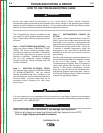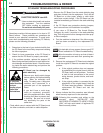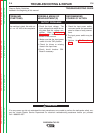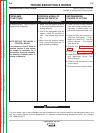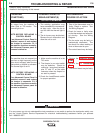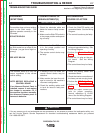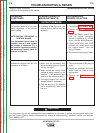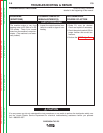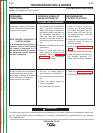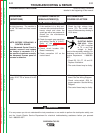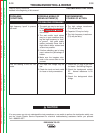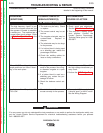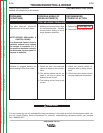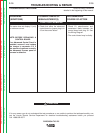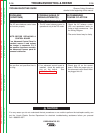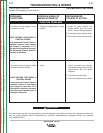
F-10F-10
PRECISION TIG 275
TROUBLESHOOTING & REPAIR
Observe Safety Guidelines TROUBLESHOOTING GUIDE
detailed in the beginning of this manual.
If for any reason you do not understand the test procedures or are unable to perform the test/repairs safely, con-
tact the Lincoln Electric Service Department for electrical troubleshooting assistance before you proceed.
Call 1-888-935-3877.
PROBLEMS
(SYMPTOMS)
POSSIBLE AREAS OF
MISADJUSTMENT(S)
RECOMMENDED
COURSE OF ACTION
TIG WELDING PROBLEMS
The machine output is intermittent-
ly lost. Gas flow and high frequen-
cy are also interrupted.
NOTE: BEFORE REPLACING A
CONTROL BOARD
If an Advanced Control Panel is
installed, remove it and replace
the Jumper in connector J-3. If
the machine functions normally,
the Advanced Process panel or
harness is defective.
1. The problem may be caused by
high frequency interference.
Make sure that the machine is
grounded properly according to
the installation instructions. If
there are other high frequency
sources in the area, make cer-
tain that they are grounded prop-
erly.
2. Make sure the Amptrol is operat-
ing properly.
3. Check to make sure that the
input voltage is correct for the
machine. Refer to Reconnect
Procedure in the Installation
section of this manual.
1. Check for loose or faulty con-
nections on the leads between
the remote receptacle, the pro-
tection board and plug J22 on
the protection board. See the
Wiring Diagram.
2. Check plugs J5 and J23 on the
protection board for loose or
faulty connections.
3. Perform the Protection Board
Test.
4. The control board may be faulty.
5. Check the ground connection of
the bypass/ stabilizer P.C.
Board. See the Wiring Diagram.
No gas or water flow (with option-
al water solenoid) when the arc
start switch or Amptrol is activated
in the TIG mode. All other ma -
chine functions are normal.
1. The gas (or water) supply is
either empty or not turned on.
2. The low regulator may be set too
low.
3. Check the supply hoses for
kinks or blockages.
4. The filters may be blocked.
1. Perform the Gas Solenoid Test.
2. The control board may be faulty.
Return to Section TOC Return to Section TOC Return to Section TOC Return to Section TOC
Return to Master TOC Return to Master TOC Return to Master TOC Return to Master TOC
CAUTION



